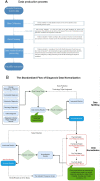Trends of pulmonary fungal infections from 2013 to 2019: an AI-based real-world observational study in Guangzhou, China
- PMID: 33620282
- PMCID: PMC7971272
- DOI: 10.1080/22221751.2021.1894902
Trends of pulmonary fungal infections from 2013 to 2019: an AI-based real-world observational study in Guangzhou, China
Abstract
Recently, the prevalence trend of pulmonary fungal infection (PFI) has rapidly increased. Changes in the risk factors for, distributions of underlying diseases associated with and clinical characteristics of some individual PFIs have been reported in the past decade. However, data regarding PFIs remain uncertain. This study reports the epidemiological characteristics and trends of PFIs over time in recent years. We applied an automated natural language processing (NLP) system to extract clinically relevant information from the electronic health records (EHRs) of PFI patients at the First Affiliated Hospital of Guangzhou Medical University. Then, a trend analysis was performed. From January 1, 2013, to December 31, 2019, 40,504 inpatients and 219,414 outpatients with respiratory diseases were screened, in which 1368 inpatients and 1313 outpatients with PFI were identified. These patients were from throughout the country, but most patients were from southern China. Upward trends in PFIs were observed in both hospitalized patients and outpatients (P<0.05). The stratification by age showed that the incidence of hospitalized patients aged 14-30 years exhibited the most obvious upward trend, increasing from 9.5 per 1000 patients in 2013 to 88.3 per 1000 patients in 2019. Aspergillosis (56.69%) was the most common PFI, but notably, the incidence rates of Talaromyces marneffei, which used to be considered uncommon, exhibited the most rapid increases. In younger PFI patients, the incidence and trend of PFIs have increased. Infection by previously uncommon pathogens has also gradually increased. Increased attention should be paid to young PFI patients and uncommon PFI pathogen infections.
Keywords: Epidemiology; artificial intelligence; incidence; pulmonary fungal infection; trends.
Conflict of interest statement
No potential conflict of interest was reported by the author(s).
Figures





References
-
- Limper AH, Knox KS, Sarosi GA, et al. . An official American Thoracic Society statement: treatment of fungal infections in adult pulmonary and critical care patients. Am J Respir Crit Care Med. 2011;183(1):96–128. - PubMed
-
- Limper AH. The changing spectrum of fungal infections in pulmonary and critical care practice: clinical approach to diagnosis. Proc Am Thorac Soc. 2010 May;7(3):163–168. - PubMed
-
- Denning DW, Chakrabarti A.. Pulmonary and sinus fungal diseases in non-immunocompromised patients. Lancet Infect Dis. 2017;17(11):e357–e366. - PubMed
Publication types
MeSH terms
Supplementary concepts
LinkOut - more resources
Full Text Sources
Other Literature Sources
Medical
Miscellaneous
